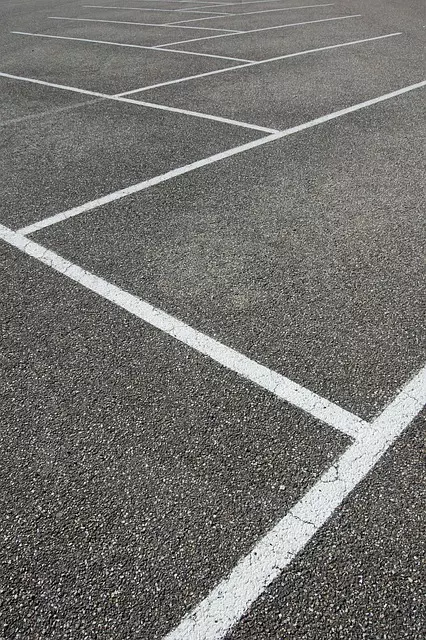In Toledo, Ohio, constructing a durable and efficient asphalt parking lot requires strategic design to manage optimal drainage, ensuring safety for vehicles and pedestrians while preserving the environment. Best practices include incorporating proper slopes, permeable pavements, catch basins, and subgrade depths tailored to Toledo's unique soil and climate. These elements work together to endure heavy use and seasonal variations, with regular maintenance and inspections extending the lifespan of the asphalt and reducing water damage risks. In Toledo, Ohio asphalt parking lot construction, professional contractors apply these best practices to create pavements that are both durable and efficiently draining, catering to both commercial and residential sectors. The emphasis on sustainable practices not only extends the life of the pavement but also protects local waterways by mitigating runoff pollution. Toledo's commitment to innovative solutions like permeable pavements and advanced retention and detention systems highlights its position as a leader in adaptive urban development, emphasizing sustainable asphalt parking lot construction practices. These initiatives not only enhance safety but also underscore Toledo's dedication to responsible water management and environmental stewardship.
Effective drainage in asphalt parking lot construction is pivotal for maintaining safety and functionality. This article delves into the intricacies of asphalt parking lot drainage systems, offering insights tailored to Toledo Ohio’s unique climatic conditions. From design considerations that optimize water runoff management to advanced technologies like catch basins and permeable pavements, we explore best practices and maintenance strategies for ensuring long-term efficiency. Additionally, case studies highlight successful drainage solutions implemented in the Toledo area, underscoring the importance of robust construction techniques for weathering the elements.
- Understanding Asphalt Parking Lot Drainage Systems
- Best Practices in Toledo Ohio Asphalt Parking Lot Construction for Optimal Drainage
- Design Considerations for Effective Water Runoff Management in Asphalt Parking Lots
- The Role of Slope and Grades in Asphalt Parking Lot Construction for Adequate Drainage
- Advanced Drainage Technologies for Asphalt Parking Lots: Catch Basins, French Drains, and Permeable Pavements
- Maintenance Strategies to Maintain Asphalt Parking Lot Drainage Efficiency Over Time
- Case Studies: Successful Asphalt Parking Lot Drainage Solutions in Toledo Ohio
Understanding Asphalt Parking Lot Drainage Systems

Best Practices in Toledo Ohio Asphalt Parking Lot Construction for Optimal Drainage

In Toledo, Ohio, effective asphalt parking lot construction that prioritizes optimal drainage is crucial for maintaining vehicle and pedestrian safety while preventing property damage. Best practices in this region focus on strategic design elements that ensure water flow away from buildings and impervious areas. These include the incorporation of proper slope and gradient within the asphalt surface to facilitate water runoff, which directs water into designated drainage systems. Additionally, the use of permeable pavements or catch basins can significantly enhance water management by allowing water to infiltrate the ground rather than pooling on the surface. The choice of materials and the depth of the subgrade are also critical factors; these should be tailored to the local soil conditions and climate, ensuring that the asphalt parking lot construction in Toledo, Ohio can withstand both heavy usage and seasonal weather changes.
Furthermore, regular maintenance and inspection are integral parts of upholding the integrity of an asphalt parking lot’s drainage system. In Toledo, the combination of robust construction practices with ongoing care leads to extended longevity of the pavement and minimizes the risk of water-related damage. Professional contractors who specialize in Toledo Ohio asphalt parking lot construction are well-versed in these best practices, leveraging their expertise to create durable, safe, and efficiently draining surfaces that meet the needs of both commercial and residential properties. Adhering to these guidelines not only promotes the longevity of the pavement but also contributes to the protection of local waterways by preventing runoff pollution.
Design Considerations for Effective Water Runoff Management in Asphalt Parking Lots

Effective water runoff management in asphalt parking lots is a critical aspect of their design, particularly in regions with significant rainfall like Toledo, Ohio. During heavy precipitation events, an improperly designed parking lot can lead to water accumulation, which may cause flooding, property damage, and environmental issues. To mitigate these risks, asphalt parking lot construction must prioritize slope and drainage systems. The optimal design should include a strategic gradient across the surface to facilitate natural runoff towards designated collection points. These gradients are essential for directing water into properly sized and installed catch basins, which channel the water into an under-lot drainage system or directly to a storm sewer.
In Toledo, Ohio, asphalt parking lot construction must adhere to local building codes and environmental regulations that address water runoff management. Engineers and contractors specializing in asphalt parking lot construction in Toledo should consider the porosity of the soil, the frequency and intensity of rainfall, and the potential for water to flow onto adjacent properties or natural habitats. Employing permeable pavements or installing retention and detention systems can further enhance water management capabilities. These solutions not only prevent water from overwhelming the local drainage infrastructure but also promote sustainable water management practices that are beneficial for both the environment and the longevity of the asphalt parking lot itself.
The Role of Slope and Grades in Asphalt Parking Lot Construction for Adequate Drainage

Advanced Drainage Technologies for Asphalt Parking Lots: Catch Basins, French Drains, and Permeable Pavements

When addressing the drainage challenges in asphalt parking lot construction, particularly in areas like Toledo, Ohio, where heavy rainfall is common, advanced drainage technologies play a pivotal role. Catch basins are a critical component in managing surface water. These strategically placed fixtures collect runoff and debris, channeling it into a system of underground pipes that direct water away from the parking lot and into a larger stormwater management system. This not only prevents standing water on the lot but also mitigates the risk of hydrostatic pressure that could damage the underlying soil or infrastructure.
French drains complement catch basins by providing an additional layer of protection against water infiltration. Incorporated into the subgrade or around the perimeter of the parking lot, these gravity-fed systems consist of a perforated pipe surrounded by gravel and enclosed in a filtering fabric. Water seeping through the soil is intercepted by the fabric and drained into the perforated pipe, which redirects it to a designated area for disposal or further treatment, thus preventing water from pooling on the surface or saturating the subbase, which could lead to structural compromise.
Another innovative solution in asphalt parking lot construction is the use of permeable pavements. These systems allow water to percolate through the pavement surface and into underlying aggregate layers, where it is either naturally filtered and absorbed by the ground or collected and diverted. Permeable pavements reduce the need for extensive drainage systems and can serve as a sustainable approach to managing stormwater runoff. They are particularly effective in Toledo, Ohio, where the climate and soil conditions often favor infiltration-based solutions over traditional piped systems. These advanced technologies not only enhance the longevity of asphalt parking lot construction but also contribute to environmental sustainability by reducing the risk of pollutants entering waterways and ensuring that the water is managed responsibly.
Maintenance Strategies to Maintain Asphalt Parking Lot Drainage Efficiency Over Time

Regular maintenance is a critical aspect in preserving the drainage efficiency of an asphalt parking lot, ensuring longevity and safety for users. Effective drainage systems within asphalt parking lot construction are designed to channel water away from structures and walkways, preventing flooding, erosion, and damage to the surrounding environment. In Toledo, Ohio, where seasonal variations can be harsh on infrastructure, proactive maintenance strategies are particularly vital. These include routine inspections to identify clogged drains or damaged pipes that could impede water flow. Clearing debris and sediment from catch basins and grates is essential, as these obstructions can significantly reduce drainage capacity.
To maintain asphalt parking lot drainage efficiency over time, it’s important to implement targeted strategies such as sealcoating. This protective layer not only enhances the appearance of the pavement but also seals small cracks that could otherwise allow water to infiltrate and undermine the subbase. Regularly grading the lot to maintain proper slope towards drainage outlets ensures that water flows as intended, rather than pooling on the surface. Additionally, the base material beneath the asphalt should be inspected and maintained to prevent compaction or degradation, which can compromise drainage. In Toledo, Ohio, where the combination of heavy snowfall and rainstorms can test the resilience of any parking lot, a well-designed and consistently maintained drainage system is indispensable for asphalt parking lot construction that withstands the test of time.
Case Studies: Successful Asphalt Parking Lot Drainage Solutions in Toledo Ohio

In Toledo, Ohio, effective asphalt parking lot drainage solutions have been successfully implemented, showcasing the region’s commitment to sustainable infrastructure and flood prevention. One notable case study is the transformation of a large commercial parking lot that previously struggled with water accumulation after heavy rains. The solution involved a comprehensive overhaul of the parking lot’s drainage system, incorporating advanced slope design and the installation of high-capacity storm drains to ensure optimal water flow away from the property. This project not only mitigated flooding risks but also extended the lifespan of the asphalt parking lot construction through strategic water management practices.
Another successful case is the implementation of a permeable pavement system in a high-traffic retail parking area. This innovative approach allowed for water to seep through the asphalt and into an underground system, which then directed it to designated areas for proper disposal or reuse. The results were immediate: reduced standing water, less erosion around the lot’s perimeter, and a significant improvement in the overall safety and usability of the parking area. These Toledo, Ohio projects serve as prime examples of how asphalt parking lot construction can be significantly improved with thoughtful drainage solutions, demonstrating the city’s leadership in adaptive and sustainable urban development.


